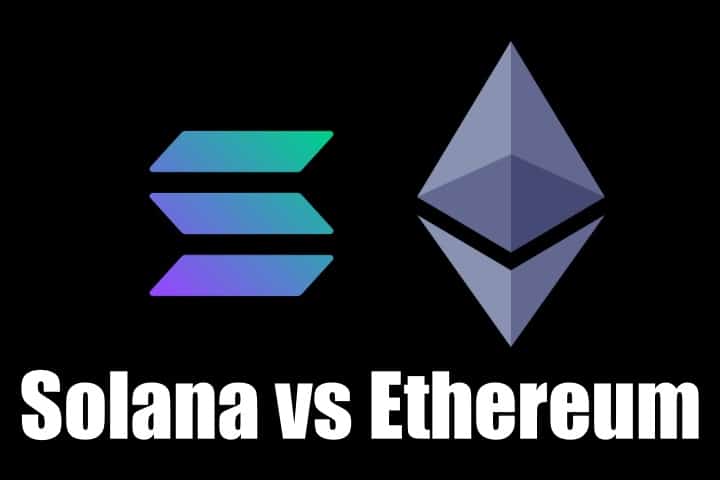Is Solana Better Than Ethereum?
Even with all the global problems related to technology — component shortages, bans, hacks, and more — the crypto market continues its unstoppable advance, providing new opportunities for those who are able to see them.
While nothing seems to move Satoshi Nakamoto’s first-born daughter from its top spot in the cryptocurrency rankings, it seems like a whole army of new projects is trying to topple Ethereum from its well-earned second place.
Currently, Solana is one of the most solid projects that are seeking to replace Vitalik Buterin’s blockchain, not in vain, it has earned the nickname of “Ethereum killer.”
But is Solana better than Ethereum as many experts claim?
Let’s analyze the panorama…
Solana vs Ethereum – The Current situation
Solana is an open-source blockchain project that aims to provide a robust, fast, and scalable platform for the development and execution of next-generation DApps that surpasses anything seen so far.
Solana has been developed from scratch using a new consensus algorithm called Proof of History (PoH) that promises to increase the speed and scalability of the network to new levels, potentially being able to process tens of thousands of transactions per second (tps).
In addition, Solana has its own cryptocurrency called SOL, which in 2020 was still valued for less than $10, but in recent months it has seen its price skyrocket, staying close to $200 at the time of this blog posting, with a market capitalization of $406B, according to CoinMarketCap.
Solana has managed to build in a very short time — remember that it was founded in 2017 — a robust ecosystem with a good number of developers giving their support to the project with their DApps, but especially in the NFTs segment.
And what about Ethereum?
Ethereum, the super-popular decentralized open-source platform for programming smart contracts and DApps, has held its position, gaining and gaining value even with the technical problems it faces today.
Still, thousands of developers around the world continue creating smart contracts and DApps on Ethereum and invent new types of solutions, many of which are used by large companies and organizations around the world.
Meanwhile, its cryptocurrency Ether, the “fuel” for operations within the network, hasn’t stopped increasing its value, slowly but firmly, although still staying a long way from the almighty Bitcoin.
With that said, it’s now the time to see in more detail, the position of each project based on several factors that I consider critical for a modern blockchain.
How Solana compares to Ethereum
1. Scalability
Solana
Solana is a blockchain that makes use of the Proof of Stake (PoS) consensus algorithm to improve efficiency when processing transactions on the network. This already means a significant saving of resources, both in hardware, as well as in time and energy. But in addition, Solana adds a support algorithm developed specifically for this network and which has been called Proof of History (PoH).
In simple words, what this algorithm does is allow network validators to process transactions as they’re generated, without having to wait for a block to complete.
This simple mechanism allows a greater number of transactions per second to be processed simultaneously, being able in theory to process up to 50,000 tps or more under certain conditions, at the same time that it manages to maintain very low fees with an average price of $0.00025.
Ethereum
For its part, Ethereum currently uses the Proof of Work (PoW) algorithm, the same one used by Bitcoin and which requires a large amount of energy and resources to function.
This system only allows the Ethereum network to process a maximum of 30 tps, which, added to the huge user base of the network and the large number of transactions that take place every day, results in the network becoming frequently congested, also increasing the price of the fees, which in many cases reach hundreds of dollars for a single transaction.
However, the next major Ethereum update, 2.0, will focus on migrating the network from PoW to PoS, which will theoretically increase the number of transactions from 30 tps, up to 100,000 tps.
2. Interoperability
Solana
The development team behind Solana is already working on implementing the Wormhole protocol in its network in collaboration with the company Certus One. Wormhole will act as a communication bridge so that Solana can interact with other networks, but in some first tests, it’ll allow communication with the Ethereum network.
Subsequently, new bridges will be added to the Solana network to enable communication with other blockchains and to be able to carry out asset movements seamlessly and in a fast and efficient way.
Ethereum
Currently, Ethereum doesn’t have its own project to achieve interoperability with other networks, but there are already several third-party projects that are offering to add this functionality to the network, something key for its future growth.
Some of these projects include:
- Chainlink – An interoperability solution especially useful for projects that need to access data from other networks without directly interacting with them.
- Wanchain – A project that will make communication between both public and private blockchains possible through a secure and private system for the exchange of value and data called T-Bridge.
- Aion – A communication system between blockchain networks that will make use of Artificial Intelligence.
- Block Collider – A project that seeks to achieve interoperability between networks using a consensus algorithm called Proof of Distance (PoD) and that doesn’t require validators.
Just to name a few.
3. Smart contracts and DApps
Solana
Solana has a protocol called Sealevel that gives it the ability to create and execute multitasking smart contracts in parallel with the rest of the transactions on the network. This is one of the key features that will allow it to achieve greater scalability.
In addition to this, the Solana network has managed to build, since its foundation in 2017, a robust DApps ecosystem that currently already has nearly 500 projects in its network.
Ethereum
In this regard, there is no doubt that Ethereum is the world’s leading network for blockchain-based solutions. In this sense, the Ethereum network already has more than 3,000 fully functional DApps in all kinds of categories, especially in DeFi and more recently, in the NFT segment.
All this is possible thanks to the use of its standard ERC-20 and ERC 721 tokens, which allow interoperability between different DApps within its network.
4. Tokenomics
Solana
Despite being founded in 2017, Solana already has a market capitalization close to $50B, thus placing its SOL token among the most important cryptocurrencies in the world.
SOL has a maximum supply of 489 million coins, and its market value is close to $200, a significant increase considering that in 2020 it was valued at just $2.
However, it’s important to note that due to certain inflationary elements established by the developers, the price of the cryptocurrency will tend to be somewhat more volatile than other similar assets, with a downward trend in the future.
Ethereum
The problems that Ethereum faces at the moment are scalability and transaction costs, This is one of the factors that have kept its price at bay.
Even so, in the last 12 months, the price of Ether has increased significantly, mainly due to progress in the development of its future updates, already hovering around $3,500 at the time of publishing this blog, with a market capitalization of +$400B.
It is precisely this last factor that is helping to create pressure on the price of Ethereum, both in supply and demand, which added to the great support it has, is attracting more investors to the platform.
Which is better, Solana or Ethereum?
Although Ethereum currently has significant limitations in terms of scalability and transaction costs, this has not prevented the network from continuing to grow at a sustained rate. The platform already has 7,000 nodes and 90,000 validators.
However, this is also due to the use of the PoW consensus algorithm, something that will change shortly when PoS is implemented.
When that time comes, Ethereum is supposed to be capable of processing around 100,000 tps, which is pretty good compared to Solana’s current capacity, which is around 50,000 tps – but could theoretically go up to 500,000 tps.
For its part, although Solana only has about 600 nodes and about 1,000 validators, interest in the network hasn’t stopped growing, especially if we consider that it’s still under development.
The same must be said when thinking about DApps. Solana owns just close to 500, while Ethereum owns 3,000. Still, Solana’s growth has been remarkable in this regard.
While Solana is technically superior, Ethereum has the advantage of being on the market first, so it has a strongly established community and ecosystem that help revalue the network.
Solana is unlikely to replace Ethereum, especially since the development team of Ethereum is not going to be left behind when it comes to implementing improvements that will help it better face its competitors.
Of course, it’s a fact that when Solana is 100% functional, many people will migrate from one network to another, but probably not at a rate that will remove Ethereum from its second place in the cryptocurrency rankings.
I believe that in the future, there will be a fierce war between these two blockchains, especially in the DApps and NFTs sector, but I also believe that there is enough space for both projects to coexist. In other words, both Solana and Ethereum will have their own niche.
And in the end, Allah knows best.
PLEASE KINDLY SHARE THIS ARTICLE IF YOU’VE FOUND BENEFIT IN IT



